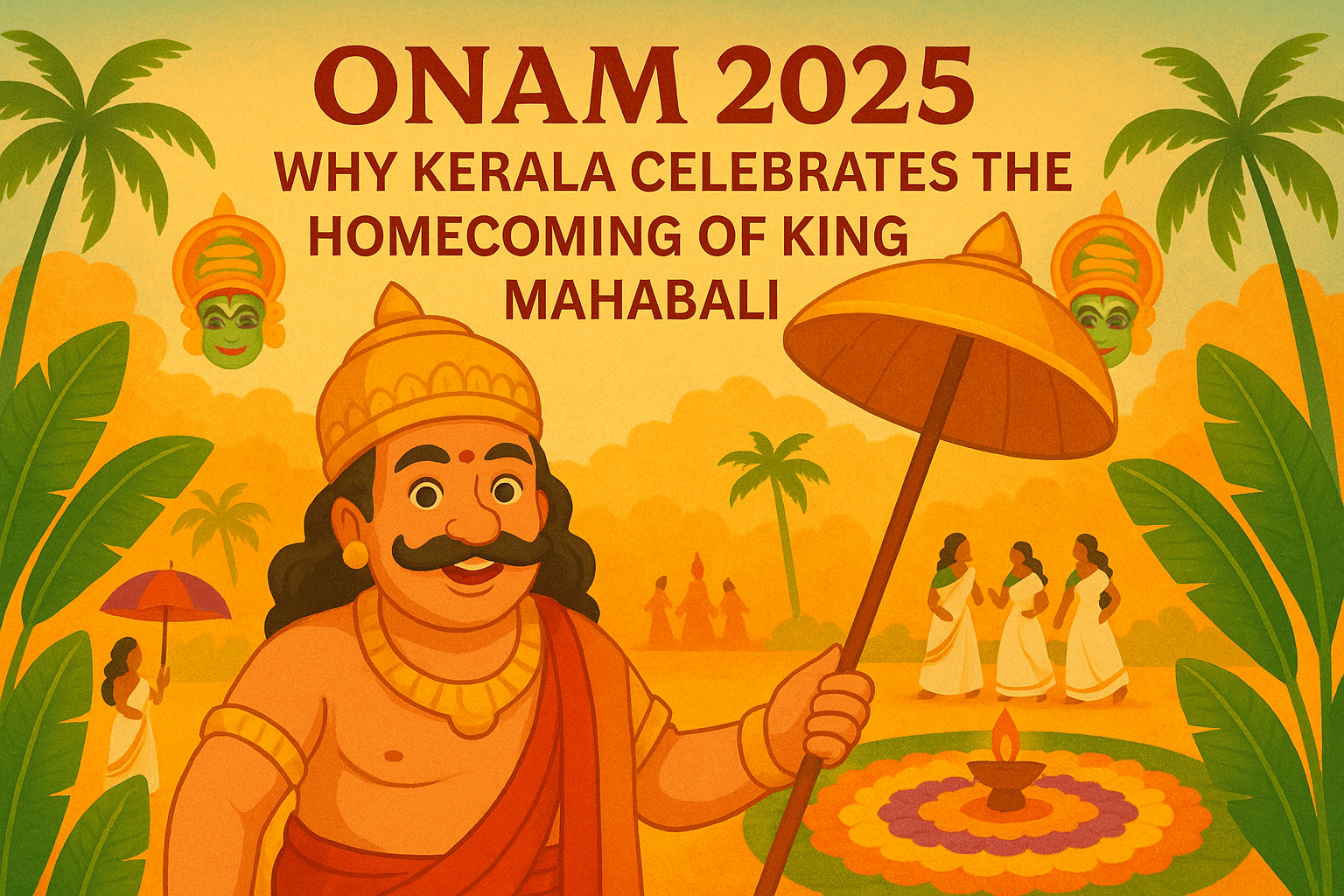
Onam 2025: Why Kerala Celebrates the Homecoming of King Mahabali
Festivals in India are not just about rituals or celebrations—they are about storytelling, identity, and community. Onam, Kerala’s grand harvest festival, is a perfect example of how myth, culture, and tradition come together to create a celebration that unites millions. Each year, in the Malayalam month of Chingam (August–September), homes across Kerala bloom with flowers, kitchens fill with the aroma of the traditional Sadya, and the air carries the joy of togetherness. But at the heart of this vibrant festival lies the legend of King Mahabali—the benevolent ruler whose homecoming marks Onam.
The Legend of King Mahabali
Every festival has a story, and Onam’s is both fascinating and deeply symbolic. According to folklore, Kerala was once ruled by Mahabali, a demon king (Asura) who was nothing like the stereotypes of cruelty or oppression. In fact, Mahabali’s reign is remembered as a golden era. There was no poverty, no crime, and no inequality—everyone lived in happiness, harmony, and prosperity.
But as often happens in mythology, too much power draws attention. Mahabali’s growing influence worried the gods, who feared that his popularity might overshadow their own authority. They turned to Lord Vishnu for help. Vishnu, in his Vamana (dwarf Brahmin) avatar, approached Mahabali and asked for land measuring just three steps. True to his generous nature, Mahabali agreed.
Vamana then grew in cosmic size. With his first two steps, he covered the entire universe. For the third step, Mahabali bowed down and offered his head, keeping his promise. Touched by this act of humility and devotion, Vishnu blessed Mahabali, granting him permission to visit his beloved people once every year. That annual visit is celebrated as Onam—a time when Kerala welcomes its legendary king home.
Onam as Kerala’s Cultural Identity
Beyond mythology, Onam is a festival of pride for Kerala. It is the state’s official festival, celebrated across religions, communities, and geographies. For ten days, beginning from Atham and culminating in Thiruvonam, Kerala becomes a stage where tradition meets festivity. The beauty of Onam lies in its inclusivity—it belongs to everyone, regardless of caste, creed, or faith, echoing the spirit of Mahabali’s golden reign.
The Rituals and Celebrations
Onam is not just a single day but a ten-day extravaganza, each day carrying its own significance:
Atham marks the beginning, with the first floral carpets (Athapookkalam) laid in courtyards.
The following days see more flowers added, symbolizing growth, beauty, and community effort.
By Thiruvonam, the tenth and most important day, households across Kerala are adorned with grand pookkalams and filled with feasts.
The rituals of Onam are as vibrant as the stories:
Pookkalam (Floral Carpets): Colorful patterns made of fresh flowers decorate homes, inviting King Mahabali with beauty and warmth.
Onam Sadya: A feast served on banana leaves, consisting of rice, curries, pickles, papad, and the sweet payasam. For many, this is the centerpiece of Onam—food as an expression of abundance.
Vallam Kali (Boat Races): The snake-boat races on Kerala’s backwaters capture the energy and spirit of teamwork, attracting participants and tourists alike.
Traditional Attire: Men wear mundu while women don the elegant Kasavu saree, adding grace to the celebrations.
The Deeper Meaning of Onam
While Onam’s rituals are colorful, its deeper message is timeless. It is a reminder of values—generosity, humility, equality, and prosperity. Mahabali’s story symbolizes selfless leadership, where a ruler prioritizes his people over personal power. His willingness to bow before Vamana shows that true greatness lies in keeping one’s word, even at personal cost.
For modern Kerala, Onam is more than mythology—it’s a cultural anchor. It reminds people of a time when society was free from inequality and injustice. In a world where divisions often dominate headlines, Onam stands as a festival of unity.
Onam in Today’s World
What makes Onam fascinating is how it has adapted to modern life without losing its soul. Cities like Kochi, Thiruvananthapuram, and Thrissur host elaborate celebrations, while Malayali families across the globe recreate the festival in their homes, often with a mix of tradition and innovation. Technology has made it easier to share Onam moments—from Instagram reels of pookkalams to YouTube vlogs of Sadya recipes. Yet, the essence remains the same: community, joy, and remembrance of a golden past.
Conclusion: Why Onam Matters
Onam is not just Kerala’s harvest festival; it is a story of values. It reminds us that leadership can be benevolent, that promises must be honored, and that equality is the foundation of happiness. The flowers, feasts, and festivities are important, but the real gift of Onam is its reminder of what society can be—a place of abundance, inclusivity, and fairness.
This year, as Kerala once again welcomes King Mahabali, Onam calls us to celebrate not just tradition but also the timeless values that make life meaningful.


